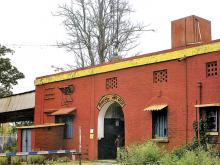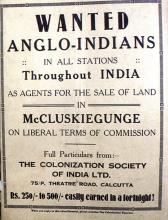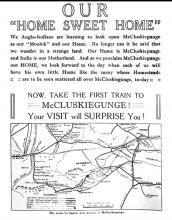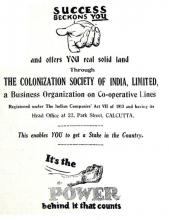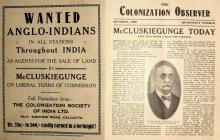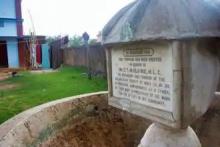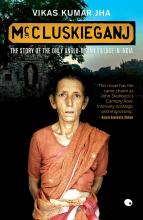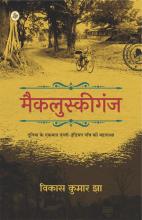In 1921 Sir Henry Gidney, a medical surgeon by profession and respected member of the Anglo-Indian community in Calcutta petitioned the British to grant land in Andaman and Nicobar Islands where the Anglo Indians could settle down. In 1923 he even sent a team of ten Anglo Indians for a preliminary survey. Three of them died and seven returned after a year with a negative report. The petition was promptly rejected by the British. In 1928 the Simon Commission clarified that British government was not willing to consider Anglo Indians as a class separate from the Indians. But Sir Gidney did not lose heart. Again in 1931 as the Anglo-Indian representative at the Round Table Conference in London he urged that the community be given 200,000 acres, one acre for every Anglo-Indian in the census. His demand was rejected.
Earnest Timothy McCluskie, a businessman and friend of Sir Gindy too was determined about the future of the community. An Anglo Indian himself, his father was an Irish railway man and his mother an Indian Brahmin. An insurance agent he dabbled part time in shares and property. His wife, a Portuguese woman used to play the organ in Calcutta’s Anglican cathedral. McCluskie rose in ranks to become a well-known member of Anglo-Indian society in Calcutta, and later a member of Bengal’s Legislative Council.
There were Anglo Indian settlements in Badra in Bombay, in Whitefield in Bangalore and Elliot Road in Calcutta. But McCluskie was of the view that Anglo Indian community too could live in a village like majority of Indians did. He tried buying land in Banaglore from McIsaac but later dropped the idea because at just thirty acres it was not large enough.
McCluskie tried buying land for Anglo Indian settlement in United provinces, Assam and Bengal and even petitioned the British Govt but failed. Finally, in the British governed state of Bihar he could convince the Maharaja of Ratu to lease out 10000 acres of land on a perpetual lease near the railway station of Lapra, about 62 kms from Ranchi. Mr. Pepy the estate manager of Maharaja played an important role in convincing his employer about the suitability of the deal. Lapra lay on the newly built loop line from Barkakana. It was overnight journey from Calcutta and hence seen as a suitable location for the settlement. The deal included three villages of Kanka, Lapra and Hesalang. The only clause that Maharaja insisted on having was that the tribals of these villages would not be relocated and had to be left undisturbed by the new settlers. The land was leased as a permanent property lease on 13th October, 1933 through the good services of Sir Henry Gidney and A.S. Bower
McCluskie now earnestly set out to establish a heaven for Anglo Indian community. The Colonisation Society of India (CSI), a cooperative, was formed in 1933. Membership was given to people with European lineage, not necessarily British. Members could buy shares and get a plot of land in return. So Portuguese Indians, French Indians, Dutch Indians and Anglo Indians all bought land. The prospectus of the Colonisation Society gave glowing description of how a ‘Chotta England’ (small England) would be established retaining the European culture. CSI was promoted through brochures and a magazine- The Colonization Observer. Land was cheap and one could buy a ten-acre plot for just Seven hundred and Twenty-six rupees. The Colonisation Observer regularly printed lists of shareholders, along with photographs of early settlers.
For the foundation ceremony of the settlement on 3 November 1934, the early settlers erected a triumphal arch of home-grown vegetables. A crowd of 300 watched as a memorial fountain was unveiled.
McCluskie died in 1935. The Lapra railway station and settlement was renamed McCluskiegunj in his honour. By 1936 almost 400 Anglo Indians had bought land and built their bungalows with well-maintained gardens, airy verandahs and tiled slanted roofs. A school, a bank and a clubhouse followed. A Roman Catholic and an Anglican church (St John Church, 1940) were built. A dentist, a doctor and a baker arrived. A cannery began to produce tinned fruit. An early settler Harris Mendies started once a day bus service (Ganga Jamuna bus service) between Ranchi and McCluskiegunj.
The sole train to McCluskiegunj would steam in from Barkakana at around 4.30 in the morning. One of the earliest settlers Mr and Mrs Kearney, ran the only canteen at the railway station. Mrs Kearney continued to run the canteen even after her husband’s death. Steam hauled trains used to stop for more than half an hour for water. Business was brisk. After her death, her servant Majid Ansari took over. With diesel engines replacing the steam engines the stop was reduced to two minutes and business collapsed. When the Railways rebuilt the canteen in 1980 it did not allot the canteen to Majid since he owed them rent. In 2011 it was proposed to build a coal siding near Platform No-3. After opposition from the locals and Pollution control board it was shelved in 2014. In 2018 the station finally had a foot over bridge.
However, the initial euphoria soon died out. By 1940 only 1/5th of the Rs.500000 paid up capital was subscribed and only 6800 acres had been sold. McCluskie had sent circulars to almost 2 lakhs Anglo-Indians residing in India. Only 450 Anglo Indians families finally purchased land here. The Colonisation Observer published its last issue in 1942. By the end of the war the cannery and shops had closed. Lack of employment opportunities meant that this colony became heaven for retired people. After independence the younger generation started migrating to Canada, England, Australia and other Indian cities. In 1955 the Colonisation Society folded up under charges of embezzlement and fraud. By 1997 the dream lay shattered with just 12 Anglo Indian families remaining.
In 1997, on the initiative of Alfred George D’ Rozario who was then the MLC of undivided Bihar the Don Bosco Academy started a school here. Being the only English medium school in the region students came flocking. Since the school did not have any lodging facility the remaining Anglo-Indian families set up student hostels at their residences. They now have a steady source of income from the many hostels here- St. Jude’s Hostel, Saint Luke’s Hostel, School View Hostel and Gordon’s Hostel
The town was the inspiration for the Hindi novel McCluskiegunj by journalist-writer Vikas Kumar Jha, published in 2011. It was translated into English by Mahasweta Ghosh in 20155. McCluskiegunj is also the setting for the 2016 film A Death in the Gunj, which is Konkona Sen Sharma's directorial debut. The movie is based on real life incident that happened here in 1979. Parts of Anupam Kher’s movie- One Day Justice delivered (2019) was also shot here too. Usha Uthup has recorded a song- McCluskiegunj is blooming as an ode to this settlement
Today the settlement is dotted with ruins of Anglo-Indian bungalow which show the ravages of time that McCluskiegunj has failed to withstand. Few of the original settlers remain. Most sold off the bungalows and land migrating overseas. Today two trains service this station daily- The Palamu Express from Patna and the Shaktipunj Express from Howrah.

